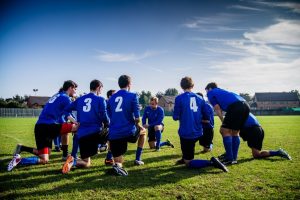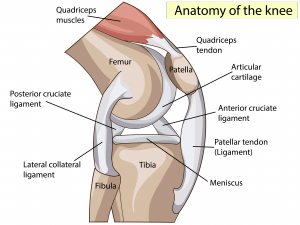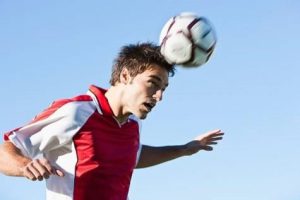Football is the most-played sport around the world. And, while its usually safer than say, rugby, or hockey, injuries can and do occur. Thankfully the application of some simple strategies can go a long way to reducing the risk, for both kids and adults. Today I’ll explore some of the most common injuries, and how we can help to prevent and treat them. 
Ask anyone at the pub how old the game of football is, and they’ll probably tell you it’s been around since “forever”. Actually, this isn’t far from correct! The first known match was played in 611 A.D. In the United Kingdom. Official rules were established in 1815, but not before the game had been banned outright a few times – sometimes for over a century!
While football today is safer than ever, injuries are still fairly frequent.
Ankle Injuries
As you might expect, ankle injuries are a frequent complaint amongst pros and hobbyists alike – however, you might not expect that the majority of ankle injuries are not the result of a dodgy tackle, but instead are primarily caused by either jumping in proximity to other players or as a result of the strain placed on the ankle during quick changes of direction[1].
These actions promote ankle instability upon landing. and are set-ups for twisting. rolling or compressing the joint.
Since it’s the forces acting on the joint which are the potential issue, protecting the ankle starts with recognition of the specific movements that expose the joint to possible harm.
Sports medicine experts recommend proprioceptive training as a method to cut down on ankle sprains and strains, especially for players with known vulnerabilities[2] Its important to remember that while a pre-existing condition or other issue affecting the joint can make injury more likely, having had a similar injury in the past can also be a risk factor.
For the seriously committed, proprioceptive instruction is an approach which provides detailed internal feedback about how the ankle moves in relation to the rest of the leg. It’s a sort of deconstruction of the body’s “locomotion” and can teach players how to “play smarter” with respect to the ankle joint.
A simpler approach is to simply bolster ankle steadiness by taping and/or bracing the area before practices and competitions[3].
Perhaps most important for us as chiropractors is the role which posture may play in heightening the risk of injury. Sports medicine research has clearly shown that too much postural “sway” heightens the risk for ankle injury.[4]
The Chiropractic care we provide at Complete Chiropractic is ideal for heading off these kinds of issues, before injury can occur. Our detailed approach to postural analysis allows us to detect and correct postural imbalances long before they become serious enough to contribute to, or cause and injury. By establishing and maintaining optimal posture its possible to reduce sway and promote better balance (which might also help you score the winning goal!)
If ankle injury does occur, you needn’t be put off the sport you love – Research shows that chiropractic therapy is an efficient and effective choice[5]
Knee Injuries
Many different sports have a tendency to overburden the knee joint, so its no surprise that we see plenty of clients suffering from knee problems, but also from back pain or stiffness related to a knee injury. The knee often bears the brunt of impact during both running and jumping and is subject to rapid flexion even during low impact sports, such as swimming . This opens the area to serious injury, either from overextension or twisting.
Football’s ubiquitous stop-jump tasks, quick changes of direction and frequent sprinting boost the risk of straining or tearing the knee‘s ligaments. particularly the anterior cruciate ligament (ACL)[6]
Sports scientists generally agree that during jumping motion patterns in the lower leg are pre-programmed prior to landing. These patterns can reduce knee flexion (the opposite of extension) and direct extra loading, or pressure to the ACL[7] – In a sense, this means our bodies are actually pre-programmed to be vulnerable to these kinds of injuries.
In one study of an NCAA Division one women’s soccer team, athletes who did special neuromuscular warm- up exercises before the game were shown to be much less likely to overstress the ACL during play.[8] This was particularly true for players with previous ACL problems.
Another research project with elite soccer players confirmed that neuro-muscular training can reduce ACL injury caused by Football’s stereotypical side-cutting manoeuvres which naturally involve changing directions rapidly[9]
Luckily, Chiropractic care offers many options for this type of neuromuscular training – while it sounds like a complicated (or perhaps painful!?) process, it certainly isn’t! In fact, just as with ankle injuries, correcting postural issues and implementing simple exercise routines is often all that’s required to guard against what can otherwise be a nasty injury.
Research also draws a strong association between decreased range of motion in the hip and ACL rupture[10]. Chiropractic care can successfully expand hip range-of-motion which in turn helps guard the player’s knee without restricting play.
If the knee does become strained. chiropractic adjustment of the knee and hip (sacroiliac joint) will lessen leg muscle inhibition and encourage healing and recovery[11] Hip and knee injuries can be painful and impinge on your quality of life off the field as well as on it – at complete chiropractic, we can also teach you simple exercises which can help to reduce pain and enhance muscle balance after injury[12].
Head and Neck Injury
 “Heading.” Has been a subject of some debate for a while now – especially as it relates to kids. While serious injury is unlikely, heading can be dangerous for the neck (the cervical spine). While the odd header probably won’t do you any harm, multiple impacts may, over time produce bony changes in the cervical spine and predispose a player to related degenerative disease later in life[13] Occasionally, it may also cause concussions.
“Heading.” Has been a subject of some debate for a while now – especially as it relates to kids. While serious injury is unlikely, heading can be dangerous for the neck (the cervical spine). While the odd header probably won’t do you any harm, multiple impacts may, over time produce bony changes in the cervical spine and predispose a player to related degenerative disease later in life[13] Occasionally, it may also cause concussions.
As a father and Chiropractor my advice would be to limit headers in so far as possible, and probably to avoid them altogether for young kids (they should be concentrating on developing magic feet anyway!).
Thankfully. recent studies do not correlate intentional heading with reduced cognition[14] and a large number of headers being performed over the course of a career does not appear to affect neuro-psychological abilities in (adult) footballers, but its often best to play it safe with our youngest players.[15]
Chiropractic care incorporates knowledge of the numerous position changes the cervical joints undergo as they support the head[16] And studies show that proactive chiropractic adjustment is safe and effective as a support mechanism for the cervical spine[17].
Hamstring Injuries
Most people have a distinct preference for one leg over the other when it comes to kicking. Research confirms that this predilection carries over into football, even when both legs are extensively trained.[18]
As a standalone point, this kind of thing isn’t really much of an issue, however – leg-choice habits may become a problem when fatigue sets in. As a player tires strength in both the quadriceps (frontal thigh) muscle and hamstring tendon tends to reduce. This can create an imbalance. which alters stability. Even in the fittest athletes there is a tendency for these kinds of issues to arise, since the fundamental problem is the imbalance, rather than the absolute strength or fitness of the muscles.
Worse, the risk for injury is directly correlated with player fatigue, so that the chance of injury continues to rise as the player becomes even more exhausted.[19]
Recent tests at the University of Nevada showed that six weeks of hamstring strength-training can be effective in reducing the chance of injuries, both to the hamstring and the knee[20] and it is Widley accepted that warm-up stretches and flexibility exercises are also beneficial[21], however to avoid hamstring injury a pre-season visit to the chiropractor might actually be the best investment you can make. Just a quick check-up can help to ensure proper lumbar-pelvic mechanical performance[22] and ensure that your fundamental risk of injury is as low as possible going into the game.
Individual chiropractic techniques performed regularly will continue to expand hamstring flexibility, which is an effective method to reduce injury, but may also play a role in improving performance.[23]
Longer term Chiropractic care can also help to address the longer-term cause, by working to restore leg strength balance. This restoration cuts the prevalence of muscle and hamstring injury significantly over time. [24]
Also bear in mind
Always try to practice good general health and take a moment to look after your body, especially during intense exercise. Preventative care is always more effective than the treatment of an injury!
Try performing a few low-intensity activities during halftime in order to keep muscles warm.
Proper hydration is another key to dodging injuries and sustaining performance intensity[25]
Off the field, consider taking antioxidant supplements. Including coenzyme Q l0. – a Spanish study suggests that this might help to reduce oxidative damage incurred during play. While Q-10 isn’t always cheap, Vitamin C is an effective and affordable antioxidant. [26]
Chiropractic care for footballers
The best thing about the kind of integrated treatment we provide at complete chiropractic is the fact that we can address all of the issues above all at once, since a chiropractic adjustment is a quick and painless way to optimise your health. Your 15 minute adjustment appointment might be the key to keeping you on the field all season long.
As always, if you have any questions, or would just like some more information please do get in touch!
[1] J Athl Train 2007:42:38l-7
[2] Am J Sports Med 2007;135:922-6
[3] J Athl Train 2004139185
[4] Clin J Sports Med 2000;l0:239~44
[5] Australas Chiropr Osteopathy 2002:l0:2l-30
[6] Am J Sports Med 2007:35:235-41
[7] Am J Sports Med 2007:35:235-41
[8] Am J Sports Med 20081361476-83
[9] C/in J Sports Med 2008;l8:329-37
[10] Arthroscopy 2008;211:1034-7
[11] J Manipulative Physio Therayp 2000:23:76-80
[12] Clin JSport Med 2000:1022-8
[13] Pain Physician 2005:8391-7
[14] Res Q Exerc Sport 2008;79:235-44
[15] J C /in Exp Neuropsychol 2007;22:1-l0
[16] Spine 2007;32:E692-701
[17] Spine 20071322375-8
[18] Dev Psychabiol 2008 Epub)
[19] Int J Sports Med 2007:28:952-7
[20] J Strength Can Res 2007;21:41-7
[21] Scand J Med Sci Sports 2008: 18:40-8
[22] Chirnpr Ostenpat 2005;l3:4
[23] J Manipulative Physial Ther 2006;29:224
[24] Am J Sports Med 2008;36:l469~75
[25] J Strength and Res 200812211394-401
[26] Eur J App Physio 2008 Epub

